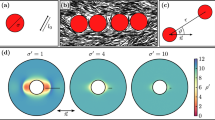Abstract
This paper presents a simulation study for self-assembling process of colloidal particles into two-dimensional arrays due to capillary immersion force. Discrete element method is used to simulate the dynamics of colloidal particles trapped in a thin liquid film. The previous model is improved in the following two points: a modification of the screening effect of capillary immersion force and introduction of periodic boundary condition. Snapshots provided by the simulations agree well with experimental images taken by atomic force microscopy. The self-assembling process is quantified with pair correlation function and coordination number. At lower coverage, colloidal particles rapidly form small clusters that consist of several particles in the early stage. Subsequently, chain-like structures with some branches are mainly generated. On the other hand, at higher coverage, large domains of hexagonal close-packed (HCP) structures are gradually generated. The rate of the growth of HCP domains is much slower than that of the generation of the small clusters and the chain-like structures.
Similar content being viewed by others
References
Burmeister F., W. Badowsky, S. Wieprich, J. Boneberg & P. Leiderer,1999. Appl. Surf. Sci. 144¶ 145, 461.
Cundall P.A. & O.D. Strack, 1979.Geotechnique 29, 47.
Denkov N.D., O.D. Velev, P.A. Kralchevsky, I.B. Ivanov, H. Yoshimura & K. Nagayama, 1992. Langmuir 8, 3183.
Dushkin C.D.,G.S. Lazarom, S.N. Kotsev, H. Yoshimura & K. Nagayama, 1999. Colloid Polym. Sci. 227, 914.
Kralchevsky P.A. & K. Nagayama, 1994. Langmuir 10,23.
Matsushita S.I., T. Miwa & A. Fujishima, 2001. Langmuir 17, 988.
Maenosono S., C.D. Dushkin, Y. Yamaguchi, K. Nagayama & Y. Tsuji, 1999a. Colloid Polym. Sci. 277, 1152.
Maenosono S., C.D. Dushkin & Y. Yamaguchi. 1999b.Colloid Polym. Sci. 277, 993.
Nagayama K., 1996. Colloid Surface A 109,363.
Okubo T., S. Chujo, S. Maenosono & Y. Yamaguchi, 2003, J. NanoparticleRes. 5, 111–117.
Sun S., C.B. Murray, D. Weller, L. Folks & A. Moser, 2000.Science 287, 1989.
Tsuji Y., T. Kawaguchi & T. Tanaka, 1993. PowderTechnol. 77, 99.
Xia Y., B. Gates, Y. Yin & Y. Lu, 2000. Adv. Mater.12, 693.
Author information
Authors and Affiliations
Corresponding author
Rights and permissions
About this article
Cite this article
Nishikawa, H., Maenosono, S., Yamaguchi, Y. et al. Self-Assembling Process of Colloidal Particles into Two-Dimensional Arrays Induced by Capillary Immersion Force: A Simulation Study With Discrete Element Method. Journal of Nanoparticle Research 5, 103–110 (2003). https://doi.org/10.1023/A:1024489832472
Issue Date:
DOI: https://doi.org/10.1023/A:1024489832472




